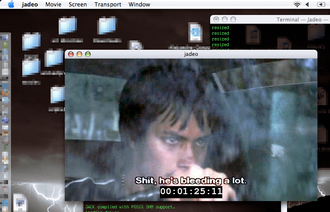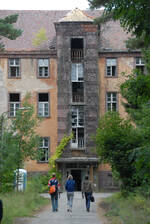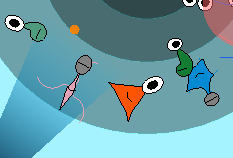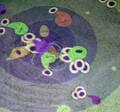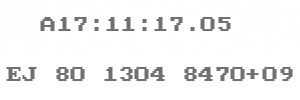 It's been almost two months since the last post which I mostly spent pushing open-source tools to the limit with film-postproduction.
It's been almost two months since the last post which I mostly spent pushing open-source tools to the limit with film-postproduction.
Looking at the rushed scans for the Wicked offline-edit, I noticed that some sound-clips have gone missing and only the 16 bit versions of the audio have been synced to the new-timecode. No EDL has been provided by Filmmore either. dang.
Before starting to count frames, slates and reels: The scanned pictures contains a printed version of the camera-timecode which was derived from the audio-recorder's SMPTE/LTC. So if one could parse the camera timecode one can relate the original-audio clock to the timecode of the offline-video..
Since the original EDL was no-where to be found and a second scan is not an option, I set out on this unusual workflow:
dump timecode for each audio-file
decode each video-frame, crop the timecode and OCR it to
ASCII text. Then save the frame-number along with each detected timecode.
assign audio-files for given timecode to the video-frame, reassign audio-timecode (drop gaps) and write EDL that matches the analyzed video.
 I'd estimated it to take 3-4 hours and ended up spending a day:
I'd estimated it to take 3-4 hours and ended up spending a day:
Already the first step introduced quite some delay: sfinfo does not inform one about extended WAV headers. libsndfile supports it and I was looking for sndfile-info -b but was more quick to write some c-code re-using xjadeo's SMPTE parser and moved on to step two, which surprisingly was much quicker: Using vextract from sodankylä, it took less than a minute until I started to pass frames to an OSC tool. The first test with gocr was a success. I tried with tesseract and ocrad, both of which have a higher setup-cost, require more tuning and even turned out to be less efficient (char-set configuration, processing time). So gocr it is, for good measure I've forked vannotate and in not time I had two text-files: One with audio-, one with video timecode at two AM in the morning.
Step (3) turned out to take most time: I implemented the offset calculation before taking a nap; and spend another two hours to write and debug a perl-script to generate - not an EDL - but an ardour session file. You won't believe how I high I jumped when it loaded the first session with 100 clips automatically arranged on four tracks!
I justed completed step (4): bounce the tracks and master a preview DVD; quite easy with mencoder, dvdauthor and mkisofs. I've used my trusted dvdmaker script.
The sources are available with the sodankylä project and may end up as Plugins or interoperability tools for open-movie-editor, lumiera.org. Contact me if you want to push this project. For what it's worth: I've also prototyped an EDL editor using a AJAX/JSON interface to sodankylä and started to implement having learned from the prototype, but for now I'm back to sound-design. I also need to arrange travel to FOMS 2009, linux.conf.au and I received an invitation to join the SLUG club. I'm really looking forward to escape this murky and damp Amsterdam.






